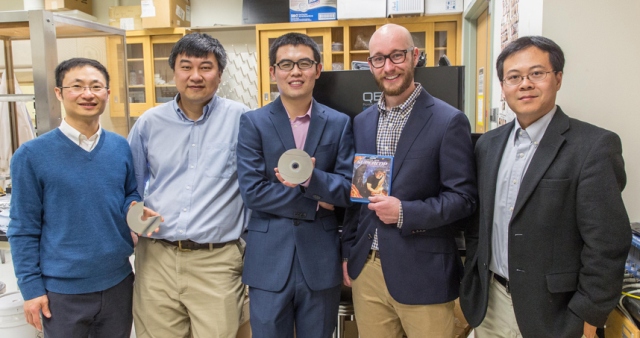 (Left to right) Dongning Guo, Cheng Sun, Chen Wang, Alexander Smith, and Jiaxing Huang. (Credit: Cheng Sun)
(Left to right) Dongning Guo, Cheng Sun, Chen Wang, Alexander Smith, and Jiaxing Huang. (Credit: Cheng Sun)
An interdisciplinary team of researchers at McCormick Northwestern Engineering have discovered that Blu-ray discs could also help improve solar cell performance. These discs have a quasi-random pattern for data storage. When this pattern is transferred to solar cells it can increase the light absorption capacity of these cells.
When compared to DVDs, Blu-ray discs possess a higher data storage density. This is due to its quasi-random pattern that it uses for data storage. The research team transferred this pattern on to the surface of solar cells.
They performed tests using patterns on various DVDs that contained different types of movies, cartoons and other types of content. The team discovered that the content did not influence the efficiency. Patterns transferred from all types of DVD provided the same enhancement for light absorption.
We had a hunch that Blu-ray discs might work for improving solar cells, and, to our delight, we found the existing patterns are already very good. It’s as if electrical engineers and computer scientists developing the Blu-ray technology have been subconsciously doing our jobs, too.
Jiaxing Huang, a materials chemist and an associate professor
Textures that are placed on solar cells increase cell efficiency by effective scattering of light. Researchers have been trying to find an efficient texture that can be produced cost-effectively. In Blu-ray disc’s, video information is stored as 0s and 1s in the form of pits and islands, and the resulting texture was found to improve light absorption. The pattern from Blu-ray disc was found to be better that a random pattern, which in turn was better than textures with no patterns at all.
Blu-ray standard’s data processing algorithms convert video signals into random sequence of 0s and 1s to achieve the maximum possible degree of compression. Further, controlled redundancy is added to increase error tolerance. This controls the amount of 0s and 1s that appear consecutively. The resulting pattern features pits and islands which range in size from 150nm-525nm. This benefits trapping of light by the solar cell. A typical Blu-ray patterned solar cell was found to enhance broadband absorption by 21.8%.
It has been quite unexpected and truly thrilling to see new science coming out of the intersection of information theory, nanophotonics and materials science.
Jiaxing Huang, a materials chemist and an associate professor
This study has been published in Nature Communications journal.
References and Further Reading